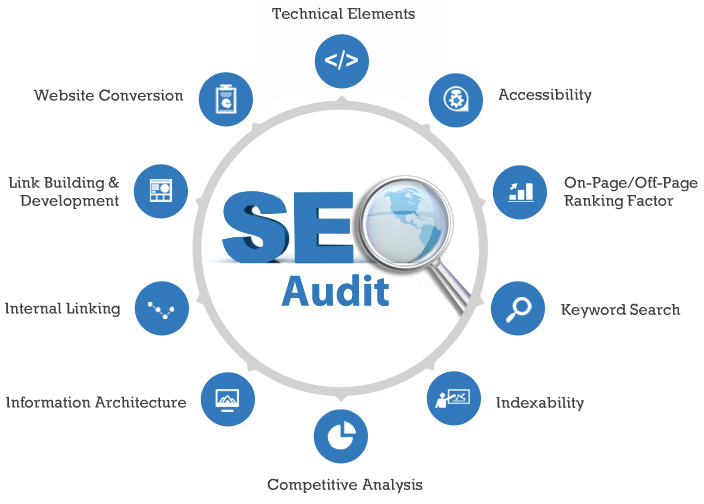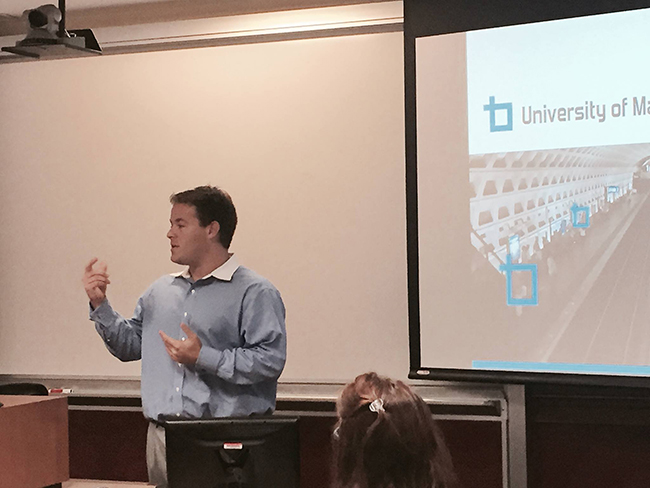Today I was honored to be asked to speak to the University of Maryland’s Smith School of Business MBA class about creative and digital marketing. The students were senior execs spanning many Fortune 500 companies across a variety of industries. The interactive dialogue was great. Jeb Brown, the MBA professor, issued three mandates for my presentation:
1 – Describe what makes a bad client
2 – Describe how to get the most out of your agency
3 – Describe the way you solve clients problems
#1 I wanted to start out with some humor. The following “client sayings” are great signals for what makes a bad client.
#2 When asked to talk about how to get the most out of your agency, I focused on this simple list…
• Be thoughtful
• Be patient
• Be open
• Be kind
• Be consistent
• Be appreciative
• Be budget-realistic
• Be schedule-realistic
• Be generous with your time
#3 When asked to describe the way Bluetext solves Marketing, Branding, and Communications challenges, I decided to use client case studies and present our methodology through the lens of each client’s custom solution. Please click the following links to learn about those stories.
1 – Google
2 – Adobe
3 – FireEye
It was a real honor to talk to so many great marketing, branding and communication executives from so many industries. The conversation was lively, with humor at times but also serious when talking about the importance of Return On Investment in the ever-changing marketing and digital world we live in. To learn more about this presentation and Bluetext please contact me.
Over the last five years there has been a lot written about the customer journey and the changing nature of how marketers must develop and present content to address a more informed customer with so many channels for gaining knowledge and insight into your product or service.
McKinsey recently found that 50% of all interactions for a customer happen during some multi-step, multi-event journey. That is why marketing automation platforms like Marketo, Pardot, and Eloqua have gained so much attention and momentum over the past few years.
At Bluetext, we are not in the business of recommending or optimizing marketing automation platforms. Anecdotally, what we hear and see from our clients and prospects is that while their enterprises are moving to these platforms, and there are technology consultants to help optimize them, the care and feeding of them with smart, relevant and consistent content is where they struggle.
Marry that with our belief that every online or offline interaction between an enterprise and their customers must deliver the same powerful, consistent brand attitude and message, and you see where we work with enterprises in the customer journey.
If you are struggling with how to deliver a clear, consistent and powerful message throughout the customer journey process, it is time to step up. You can rest assured that your prospects have noticed and have moved on to a competitor. Here are six baby steps that can make a difference in your 2015 execution.
1. Think Strategically, Not Episodically. When a client requests a quick ad or poster for an event that has just popped up, we always try to start with the why versus the what. Ask yourself the tough questions and push everyone around you to make sure that the output they are delivering helps tell your overall product or service story.
2.Is Your Content in Context? You have a new feature in your product, hired a new executive, or won a new contract…and you want to tell the world. Ask yourself so what? Why should the customer care? If the news is going to help you drive home an important message to your customer or prospect, go for it. If not, create content in the context of your customer’s pain points and ensure you hit those messages effectively.
3. Map Out Campaigns and Plans. Create Quarterly Campaign Themes that Can Drive Every Marketing Element You Plan to execute. Make sure these campaigns align with outside factors that are impacting customers, such as budgets or the seasons, and the direction of your enterprise product roadmap.
4. Deliver with Visual Impact. The world is changing. The white paper is getting replaced by infographics. Written blogs are getting enhanced with video. Are you making sure that when a customer sees anything from your organization, it is consistent and delivered with impact? Do customers get the same experience when visiting your website on their iphone as when they visit you at a breakfast seminar?
5. Put Your Customer First. Are you talking their language? Does your CTO talk about technology for the sake of technology, or how it will impact customers? If you put yourself in their shoes and stop drinking the kool-aid during your planning process, the end content and result will always be better.
6. Analyze. Analyze. Analyze. Not much needs to be said here. If you can’t measure it then you definitely can’t manage it.
Are you ready to step up your game in 2015? Whatever marketing platform you are using, you need to make sure that you are following these steps to take your prospects on a meaningful, contextual journey. We can help. Give us a call. Having an agency riding shotgun on this process can remove a lot of risk and ensure every deliverable is as impactful as possible.
In this week in 1930, following a desperate search by the radio industry for a magic bullet to increase advertising revenue, the first soap opera was born. The industry managed to convince manufacturers of household goods to sponsor programming content that appealed to their primary consumers and “Painted Dreams” debuted on WGN in Chicago – its first sponsor was no other than Colgate-Palmolive.
It didn’t take long for Proctor & Gamble to jump in and up the game with its own innovation – producing and sponsoring its own branded programming content as consumers migrated from radio to TV. That run lasted 80 years and sparked a sudden and seismic shift in the way consumers digested content.
Fast forward to the present, and technology has forced marketers to become both publishers and innovators of branded content to keep up and stay engaged with a customer whose primary screen of interest now changes by the minute.
Chief among them are the hot Cyber Security brands that have stormed onto the global technology stage – in such masse that they are desperately seeking a way to differentiate themselves and appeal to their primary customers. And just like P&G did in the 1930s – they too are producing and sponsoring their own branded content. And given the endless number of channels their customers can chose to digest it, there is no shortage of compelling examples.
Identity solutions leader Lexis Nexis’ “Fraud of the Day” franchise hits it on the nose with breach stories that keep every potential customer of theirs wide awake at night and staring at the ceiling. A simple yet brilliant concept to keep their brand in front of them daily in a contextually relevant way.
Intel & Toshiba pushed the boundaries of branded content with “The Power Inside” a blockbuster film that combined social media and technology to create an immersive, participatory experience for their primary consumer to experience their technology against the backdrop of a full feature motion picture.
http://www.insidefilms.com/en/
Palo Alto Networks has taken a less risky, more proactive and automated approach of creating a library of branded content that they license to partners and re-sellers to co-brand and amplify their industry focused solutions through what we like to call “social shrapnel” to extend the reach of their message.
http://www.computerlinks.com/fms/13679.173466_
McAfee went much farther than a library…they hired Bluetext to build an entire virtual agency on The Mall in Washington – 10 years into the future. “Future Agency” – the rich, immersive and interactive experience we created is a branded “house of content” that their primary consumer can literally fly through to access all things McAfee – branded content so appealing that it drove average time of engagement beyond the six minute mark.
http://bluetext.com/futureagency/
What does this all mean for the modern marketer in today’s increasingly digital environment? That branded content has worked effectively for nearly 100 years to engage the primary consumers it was intended to appeal to, enhanced, of course, by the technology that takes that marketing one step farther by allowing us to interact with it and share it to the friends and colleagues we think it will most appeal to. The only thing that’s changed is how they digest it.
As you plan your marketing strategy to drive visibility and demand for your brand in the red hot and highly competitive cyber security space, branded content can and should play a critical role. Even more critical is finding an agency partner with the creative firepower to “paint your dream” and drive customer engagement with a truly differentiated and professionalized branded content experience.
On Friday night, Georgetown’s McDonough School of Business kicked off its alumni weekend with an awesome party under a tent outside the Hariri Building. Great food and great company were the hallmarks of the event. In keeping with the tight partnership Bluetext has formed with McDonough over the past two years through the design and build of McDonough’s new responsive website, msb.georgetown.edu, McDonough allowed Bluetext to set up a massive screen right next to the bar (a perfect place) to showcase the new website.
In turn, our team wanted to do something special for all of the alumni who returned. We are offering organizations of Georgetown McDonough School of Business Alumni a free digital marketing assessment, including website, SEO and Social. Interested alumni can reach us at msb@bluetext.com to learn more.
Thanks to Chris Kormis, Patrick Burritt and the entire team at McDonough school of business marketing and communications team for the ongoing partnership and relationship.
“Bluetext has been the ideal partner for the McDonough School of Business at Georgetown University. Our customer journey experience with this top notch agency was collaborative, creative, and technically sound. We are proud of the work Bluetext delivered to the school and we feel the results of the platform day in and day out.”
Chris M. Kormis
Chief Marketing Officer
McDonough School of Business

Who doesn’t like inbound leads? The fruit of your content marketing labor is finally coming to bear. You sit back and the emails and calls are flying in. It is the ultimate feeling for a marketer across any industry.
Before you run to the bank, however, it is smart to ask if your website and diready to handle the leads? At Bluetext, we believe that focusing on your net is often as important as your bait.
Websites need to be structured a specific way to effectively handle inbound leads. Inbound marketing is a science and that science needs to be applied to your entire website and landing page eco-system.
Here are 10 ways to critique your site:
1. This is not your Father’s responsive website…
Does your website have iWatch and other wearables in the responsive requirements as your site evolves? The form factor requirements are changing so fast that you must make sure your site is built in a responsive manner to be able to scale.
2. Is your net sticky?
Have you looked at your retention analytics lately? How are people navigating your site? Have you buried the most impactful content elements?
3. ABC – Always be closing?
It is all about clear and easy conversion throughout the entire site. Unless prompted, most visitors will browse and then run for the hills. Make sure that the entire site, including the homepage and all interior pages, are optimized for lead capture and conversion? Does every blog post end with an “ask”? Are you asking visitors to download something premium and relevant? Are you suggesting that they follow the author or the company brand? You have to be very aggressive and show a full commitment to this opt-in.

4. Have you done an SEO audit of your website in the last year?
Remember, algorithms change. Rules change. Bing continues its growth. YouTube is more important than ever as the #3 search engine. Make sure to continuously review your keywords to capture both short and long tail opportunities.
5. What are you doing to differentiate your user experiences to drive engagement with your brand online?
Are you presenting content in new and unique ways? We have done some recent work with CSC (www.csc.com/dbc) and McAfee (www.bluetext.com/futureagency.com) to help them create virtual briefing centers to get their content out virtually to create very powerful experiences.

6. Do you have a comprehensive landing page ecosystem to address all of your organizational KPIs?
Make sure to think through all of your metrics and have a clear, concise offer to address all of them.
7. Are you updating your programmatic digital advertising buys with retargeting and other social media buying as they are evolving?
CRM and adtech are getting more close than ever. It is important to ensure that they are in synch to make sure your campaigns work as hard as they can.
8. Hide the Keywords
Get the keywords out of your meta header. Google doesn’t value them and you are sharing your seo strategy with your competitors.

9. Reverse the IP and Get Smart About Your Traffic
Many off the shelf tools can help you understand your traffic with reverse IP matching technology to let you know which businesses are reviewing your site. This is great information to share with the sales team.

10. Commit to video and interactive content
The world is changing. Think about how people are consuming data. Make sure that you are modernizing your content and delivering it in new and unique ways.
Today’s digital landscape and the unification of social, mobile, and the web into a cross-channel experience are fundamentally changing the ways our portfolio of brands engages with its customers. This new paradigm has led to an evolution of user experience (UX) into Customer Experience (CX), influencing how we approach creating digital experiences that drive business impact for our clients.
One of the implications of CX is the increased role of content management systems (CMS) in delivering and managing customer experiences across channels. In the not-too-recent past, companies implemented CMS platforms to help them manage and maintain website content, generating operational efficiencies and gaining greater control over their web properties. The new focus on CX requires that CMS must become an enabler in helping clients go to market differently and transform the way they deliver products and services.
Here are three examples of the new demands CX is placing on content management technologies:
Marketing Automation
The most effective demand generation processes are those where marketers respond individually to each prospect in the buying process. But given the volume of marketing campaigns, that’s not practical. Marketing automation gives companies the ability to manage their interactions with customers and deliver the right messages at the right times over the right channels.
Marketing automation software like Eloqua and Marketo are established solutions with proven performance. However, best-of-breed CMS need to go beyond simply enabling easy integration with current marketing automation applications and build automated targeting, testing, and analytics tools right into the content workflow.
Personalization
Digital personalization serves users content and even unique experiences based on their profile and behaviors. Delivering a more relevant, or personalized, experience results in higher user engagement and enables a website to more effectively drive key business outcomes.
Personalization takes one of two forms, explicit and implicit. Explicit personalization is straightforward. Data is gathered when the user performs an action, such as filling out a form. Content can then be customized based on what the data tells us about the user.
Implicit personalization employs passive tools like cookies to gather data about users from behavior such as page views, searches, and location.
Retailers like Amazon employ complex and extremely granular personalization that requires a significant investment in resources. However, best-of-breed CMS technologies will need to enable a personalized experience to be created with very basic user information. This means that organizations can implement a personalization strategy without the massive investment.
Multi-site
Many marketing organizations today face the need to deliver an increasing number of stand-alone and unique digital experiences for marketing campaigns, product launches, or new brands. Whether it’s a landing page, microsite, or more complex website, they frequently have new content, a unique look-and-feel, and an accelerat ed time-to-market.
CMS platforms will need to make the process of delivering large numbers of unique web experiences repeatable and scalable, taking days instead of weeks and months. Marketers are able to maintain high brand consistency while more effectively react to market opportunities.
When reviewing the current CMS landscape, products like Adobe CQ and Sitecore clearly stand out from the pack in terms of CX enablement. Another entry worth noting is Drupal.
Beginning as a flexible open-source platform for on-line communities, Drupal has evolved into a truly enterprise CMS platform, capable of delivering content-driven brand engagement and sales enablement. As a pure CMS, Drupal is powerful, yet user-friendly, with a streamlined development, admin, and publishing processes that helps accelerate a site’s time-to-market.
In the past, custom modules and expert code development could enable Drupal to deliver a degree of marketing automation, personalization, and multi-site capabilities. Acquia, the commercial open source software company that provides products and technical support for Drupal, then introduced two products that brought Drupal to the next level.
Acquia Lift –an interoperable platform that delivers testing, targeting, and analytics capabilities to simplify the delivery of personalized digital experiences. By mining and interpreting data, it automates contextual relevance to create a one-on-one conversation with users.
Acquia Site Factory –a turnkey solution that reduces the complexity of and time necessary to deploy one site or hundreds of sites. Intended for non-technical users, Site Factory allows for customized design and content, without the need for back-end Drupal development.
For companies currently on Drupal or who prefer open-source technologies, Drupal is a powerful and viable solution for customer experience management.
Decisions around digital technologies come with an investment and companies have to weigh a number of factors such as existing infrastructure, total cost of ownership, and business requirements. The emergence of CX means that ROI and revenue performance management are now starting to become part of the decision-making process. Whether you’re considering replacing your current CMS or upgrading your current system, be sure to make customer experience enablement a “must have” and a high priority requirement.








